In the landscape of online visibility, the synergy between compelling content and search engine optimization (SEO) is paramount. SEO copywriting emerges as a strategic approach, weaving together the art of captivating human readers and meeting the algorithms’ criteria for optimal visibility. This fusion aims not only to secure high rankings on search engine result pages but also to captivate and resonate with the intended audience.
What Is SEO Copywriting?

Source: Atlasiko
SEO copywriting is a specialized writing process intricately designed to cater to both the discerning eyes of human readers and the intricate algorithms employed by search engines. While traditional copywriting predominantly revolves around crafting text for advertisements, the contemporary scope of SEO copywriting extends to various forms of content creation, including blog posts and more. The primary objectives orbit around achieving prominence in search engine rankings for pertinent keywords, ultimately driving engagement and interaction from the target audience. In essence, SEO copywriting is the dynamic intersection of linguistic finesse and digital strategy, paving the way for heightened online visibility and audience connection.
Strategies for Effective SEO Copywriting:
1. Uncover Optimal Keywords
In the intricate realm of online visibility, keywords stand as the gateway between users and the vast sea of information on the internet. These are the specific words or phrases individuals input into search engines, acting as beacons guiding them to relevant content or products.
The strategic selection of keywords is instrumental in crafting content that not only resonates with your audience but also ascends the ranks of Google’s search results, propelling organic traffic to your website. Commence your keyword journey by homing in on specific terms pertinent to your niche, opting for those with moderate to low competition.

Leverage the prowess of tools such as Semrush’s Keyword Magic Tool, a beacon in the vast landscape of keyword research. Initiate the process by entering a primary keyword, commonly known as the seed keyword. This seed keyword encapsulates the essence of your niche and acts as a catalyst for unearthing an array of related keyword ideas.
As an illustration, envision managing an SEO agency with a specialization in local optimization. In this scenario, your seed keyword could be “local SEO.” The Keyword Magic Tool then unveils a comprehensive list of related keywords, meticulously arranged based on monthly search volume. Additional nuggets of information, such as search intent and keyword difficulty, provide invaluable insights.
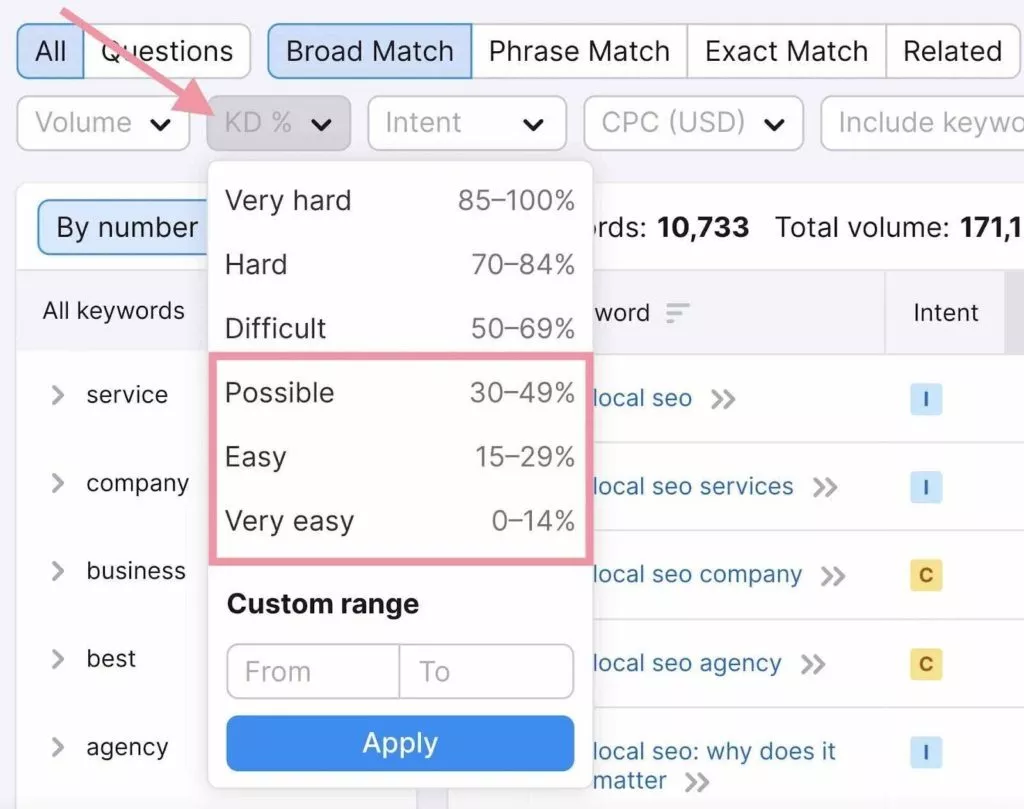
Refine your keyword selection by filtering according to keyword difficulty, denoted by the “KD%” metric, indicating the challenge associated with securing a coveted spot on Google’s first page for a specific keyword. To embark on this journey with precision, channel your initial content creation efforts towards keywords falling within the “Possible,” “Easy,” and “Very Easy” difficulty ranges. This strategic approach lays the foundation for a robust content strategy, optimizing your digital presence and beckoning the right audience to your virtual doorstep.
2. Unearth Inquisitive Insights
At the heart of every search engine’s mission lies the commitment to seamlessly connect users with valuable and pertinent information. Google, as a prime example, continually refines its Search Engine Results Page (SERP) features to enhance the search experience, aiding users in swiftly locating the information they seek.
One notable SERP feature that epitomizes this commitment is the “People Also Ask” block. Positioned strategically on the SERP, this feature presents users with additional questions intricately related to their initial search query, accompanied by concise and prompt answers.
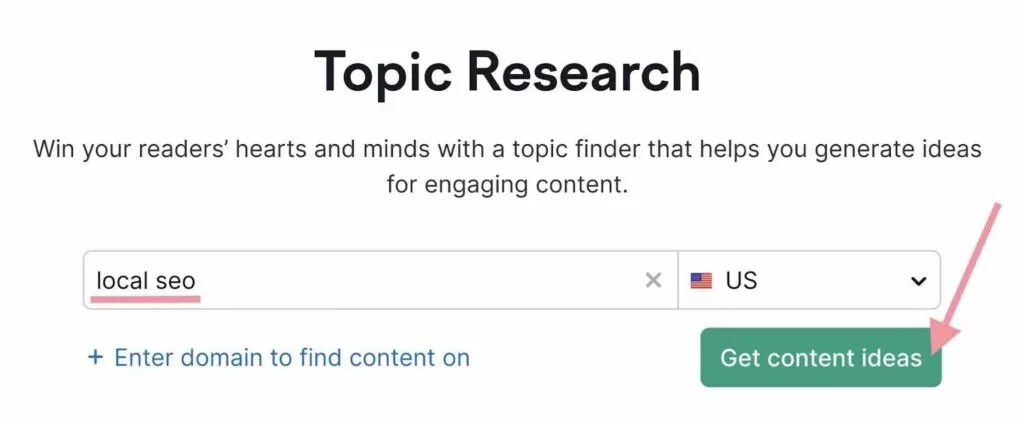
Embarking on a quest to understand and cater to the questions people are asking is a strategic approach to content creation. The “People Also Ask” feature serves as a virtual goldmine, offering insights into the queries users have regarding a particular topic.
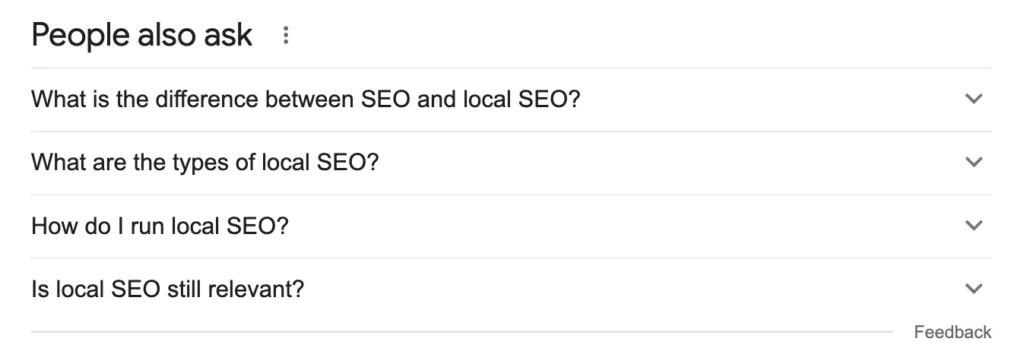
Delving into this feature not only unveils the questions users are pondering but also provides a glimpse into their specific information needs. To further enhance your quest for relevant questions, an array of tools stands ready to assist:
- AlsoAsked
- AnswerThePublic
- Quora
Yet, the pursuit of knowledge can be elevated to new heights with advanced tools like Semrush’s Topic Research. This robust tool extends beyond mere question identification, offering a comprehensive array of information, including popular headlines and related searches.
Initiate your exploration by inputting your main keyword into the Topic Research tool and clicking “Get content ideas.” Witness a plethora of cards revealing popular subtopics. The journey doesn’t end there – a simple click on any card unfurls a list of top questions, headlines, and associated searches.
Harness these valuable insights as the cornerstone for crafting content that resonates with your audience’s needs and interests. By addressing their queries directly, you not only enhance the relevance of your content but also establish your digital presence as an authoritative source catering to the curiosity of your audience.
3. Decipher and Fulfill Search Intent
Unveiling the search intent behind a keyword involves unraveling the underlying purpose behind an individual’s online quest. The fulfillment of this intent is paramount, as Google places a premium on delivering search results that precisely align with users’ objectives, thereby enhancing the overall search experience.
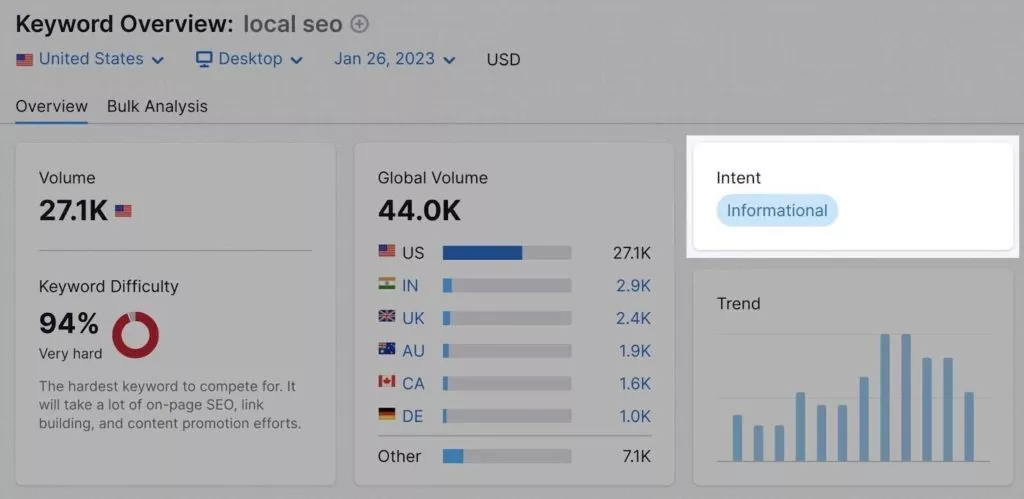
For those aspiring to secure a coveted spot in Google’s rankings, a fundamental prerequisite is the adept identification and gratification of search intent for every page within your digital domain.
The realm of search intent is broadly classified into four primary categories:
- Informational Intent: Users are driven by a quest to acquire more knowledge about a particular topic, product, or industry. Example: “what is specialty coffee?”
- Navigational Intent: Users seek to locate a specific website or page. Example: “Nespresso login.”
- Commercial Intent: Users embark on research endeavors preceding a potential purchase. Example: “best coffee machines.”
- Transactional Intent: Users are geared towards acquiring a product or service. Example: “buy a Nespresso coffee machine.”
Discerning the intent associated with a keyword is effortlessly achieved through the utilization of tools such as Keyword Overview. A concise depiction of the intent is readily available in the designated “Intent” box, providing a clear roadmap for content alignment.
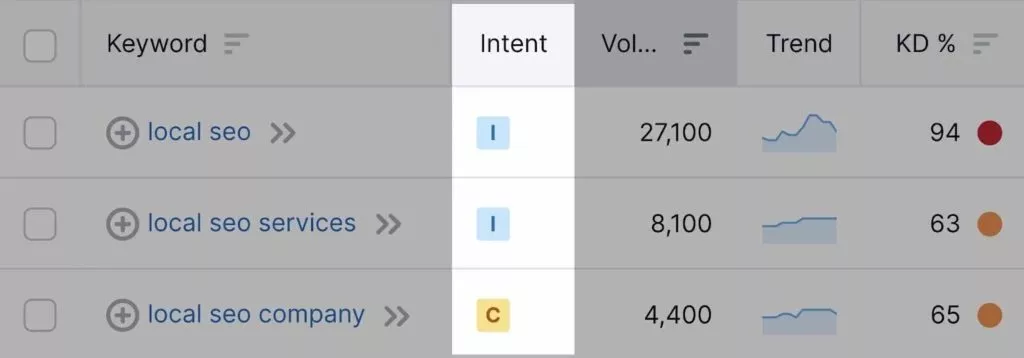
Moreover, the exploration of search intent is seamlessly integrated into the keyword research journey, especially when leveraging the functionalities of the Keyword Magic Tool. By meticulously understanding and catering to diverse search intents, you not only elevate the relevance of your content but also align your digital strategy with the dynamic expectations of your audience.
4. Analyze Competitors’ Articles to Uncover Untapped Keywords
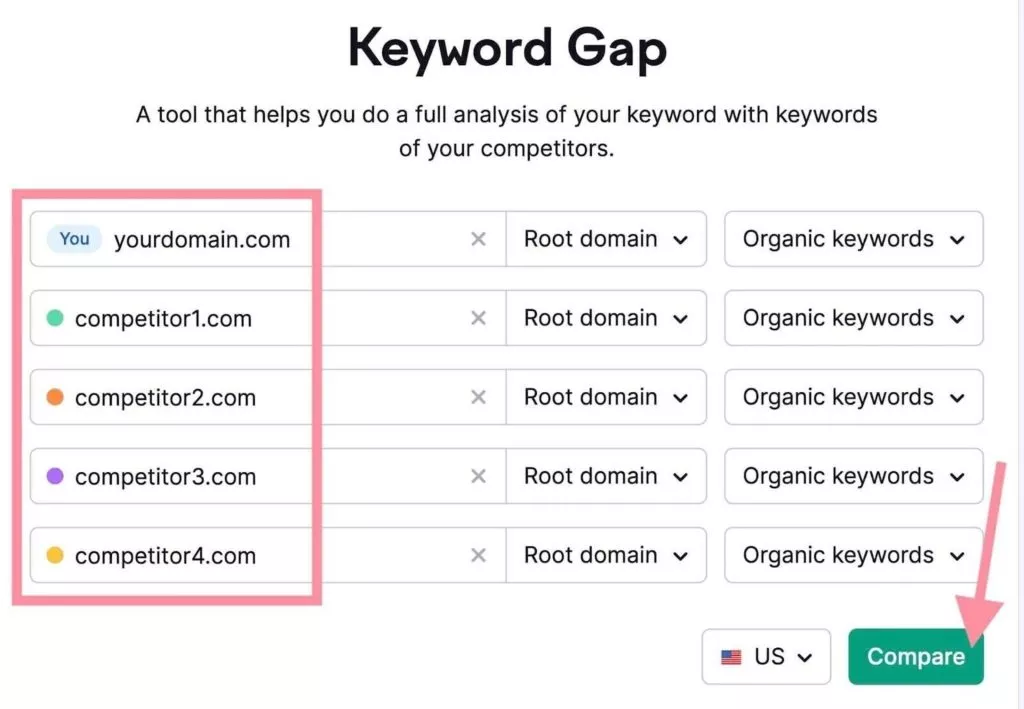
Instead of venturing into the realm of keyword targeting and content creation through speculation, why not draw inspiration from what is already resonating with your competitors? The key lies in leveraging the existing success of your counterparts and strategically building upon those foundations.
Embark on this insightful journey by uncovering the keywords that your competitors have successfully secured rankings for, but you are yet to tap into. Each of these keywords represents a golden opportunity to expand your online presence and capture additional traffic.
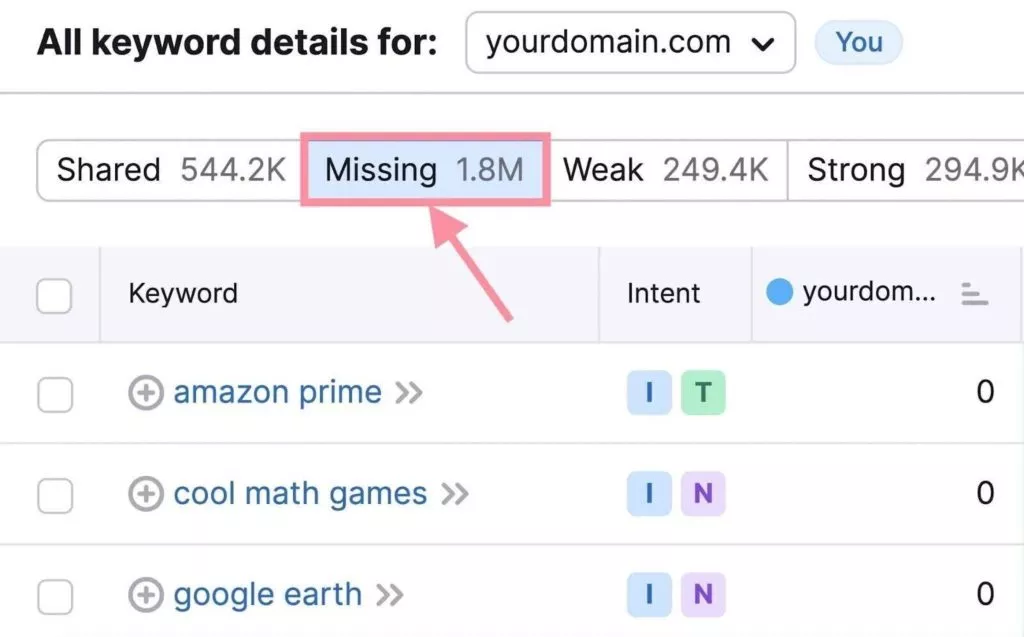
Initiate the process by navigating to Semrush’s Keyword Gap tool. Input your domain into the “Root domain” field, and enlist the domains of up to four of your primary competitors. Execute the comparison by clicking “Compare.”
Upon scrolling down, you will be presented with a comprehensive list of keywords. Utilize the “Missing” filter to pinpoint the keywords that your competitors rank for, but currently elude your digital grasp.
To further refine your strategy, employ the Keyword Difficulty (KD%) column to prioritize keywords. This column allows you to identify high-volume keywords that also offer a favorable ranking difficulty, making them optimal targets for your content strategy.
By strategically incorporating these identified keywords into your content, you position yourself to not only bridge the existing gaps but also seize untapped opportunities for increased visibility and traffic.
5. Develop Valuable Linkable Assets for SEO Success
In the intricate landscape of SEO, acquiring high-quality backlinks is a coveted achievement, and crafting linkable assets serves as a powerful strategy to naturally attract these valuable links. Linkable assets are content pieces that inherently encourage others to link back to them, contributing significantly to SEO endeavors.
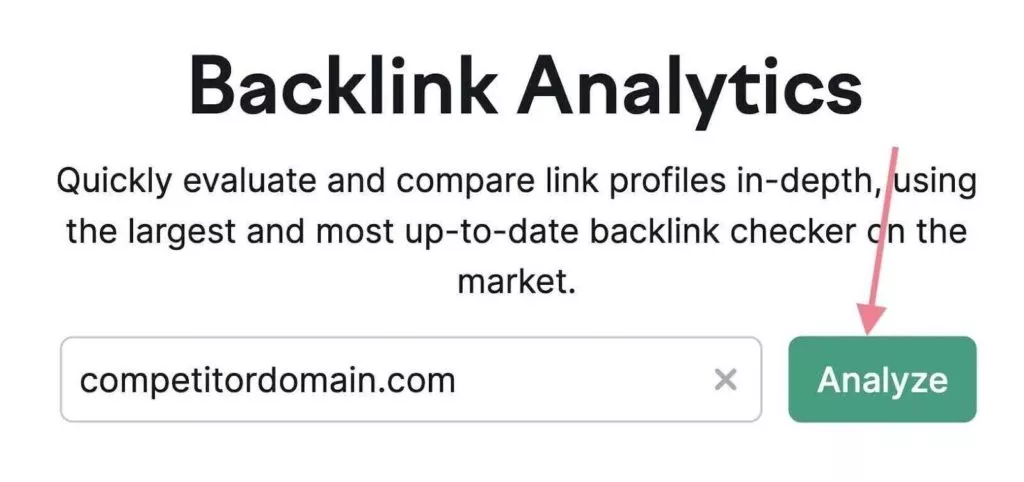
Examples of effective linkable assets encompass original research studies, compelling case studies, and comprehensive in-depth guides. However, determining the optimal content format for a linkable asset can pose a challenge. To navigate this, an effective tactic involves investigating the content that garners links within your industry.
Initiate this exploration by examining the backlink profiles of your competitors. Utilize Semrush’s Backlink Analytics tool for this purpose—enter one of your competitors’ domains and click on “Analyze.” Navigate to the “Indexed Pages” tab to identify the pages accumulating the highest number of backlinks.
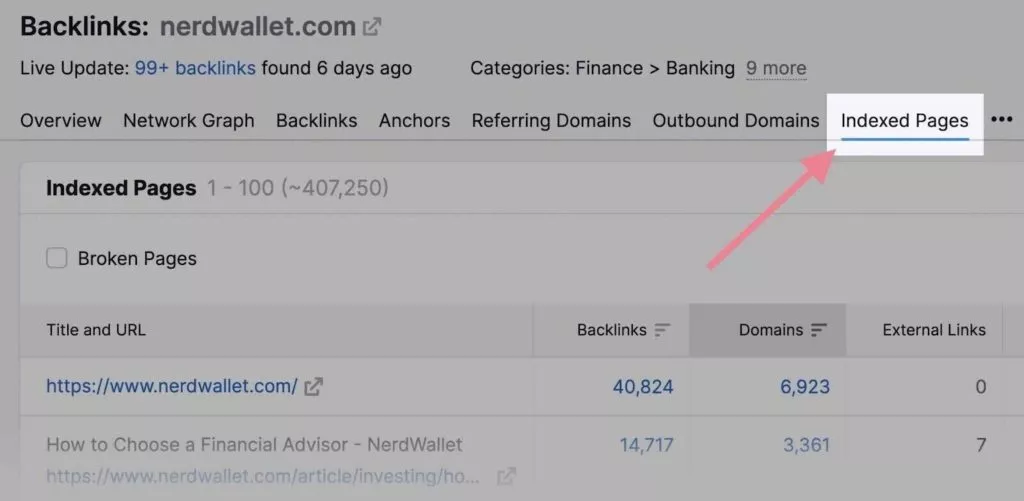
Extend this analysis to multiple competitors, discerning patterns in their top-linked pages. Consider aspects such as the inclusion of controversial subjects, the preferred content format (short-form or long-form), and the utilization of multimedia elements like images and videos.
Utilize the insights gleaned from these patterns to strategically shape your content strategy. If listicles, for instance, are widely shared within your niche, consider creating one. However, the paramount rule is to ensure that your content surpasses the quality of your competitors’ offerings. By delivering superior value, you increase the likelihood of others linking back to your content, fortifying your SEO endeavors.
6. Enhance On-Page SEO: Titles, Meta Descriptions, and Headers
In the dynamic realm of search engine results pages (SERPs), where attention spans are fleeting, optimizing key on-page elements becomes paramount for boosting organic click-through rates (CTR) and enhancing user experience. The primary components in focus are title tags, meta descriptions, and headers, each playing a crucial role in conveying information and enticing users to engage with the content.

A. Title Tags:
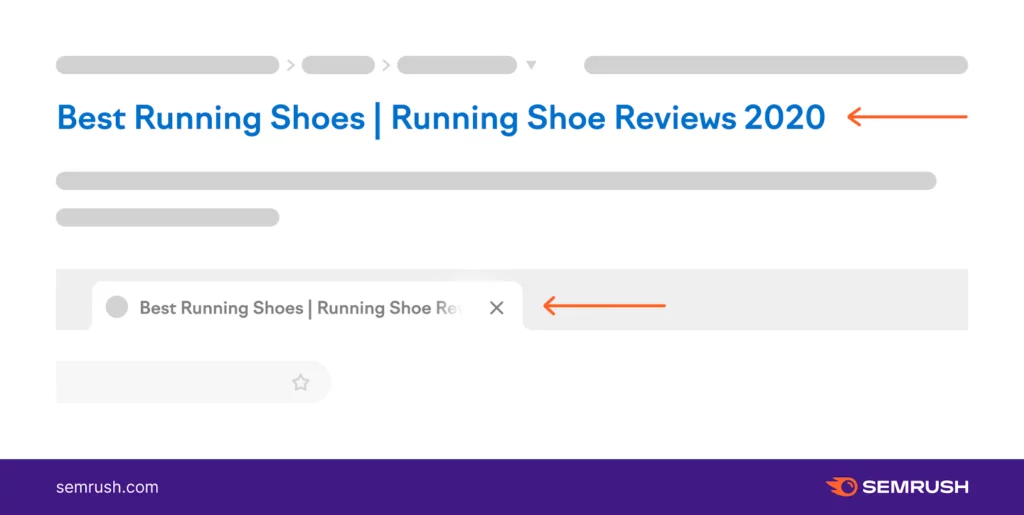
- Craft unique title tags for each page, incorporating the target keyword.
- Limit title tag length to 55-60 characters to prevent truncation by search engines.
- Ensure title tags accurately depict content, aligning with user search intent. Optimization Tip: Utilize Semrush’s Site Audit for a comprehensive evaluation of your title tags.
Learn about page authority here.
B. Meta Descriptions:
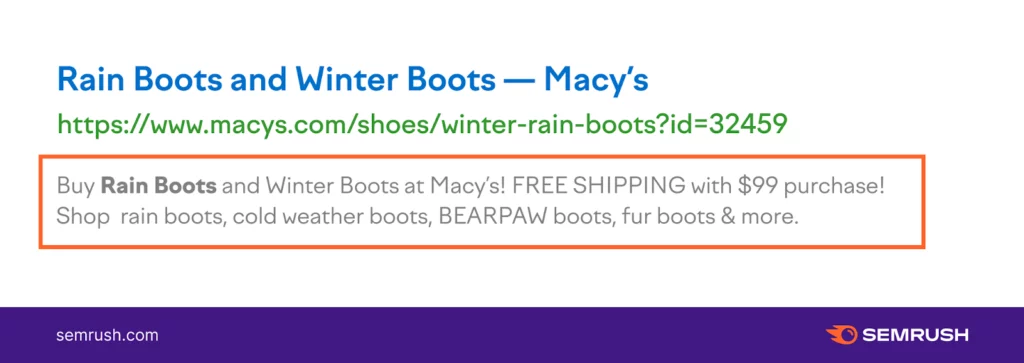
- Incorporate the page’s target keyword in meta descriptions, influencing user decisions.
- Integrate compelling calls-to-action (CTAs) to entice users to click.
- Keep meta descriptions under 120 characters, considering potential truncation on mobile devices.
- Craft unique meta descriptions for each page, accurately representing the webpage’s content. Optimization Tip: Leverage Semrush’s Site Audit to identify and address any meta description errors.
C. Headers:

- Write descriptive H1 tags, aiding search engines and users in understanding page content.
- Ensure each important page boasts a unique H1 tag.
- Employ headers to establish hierarchy and structure within the content. Optimization Tip: Utilize Semrush’s Site Audit to detect and rectify any header-related issues.
7. Craft Clear and Digestible Content
In the vast landscape of online information, users often turn to search engines for quick and concise answers. To cater to this need, it’s imperative to structure your copy in an organized and reader-friendly manner. Below are effective strategies to enhance the clarity and readability of your content.
A. Good Structure:
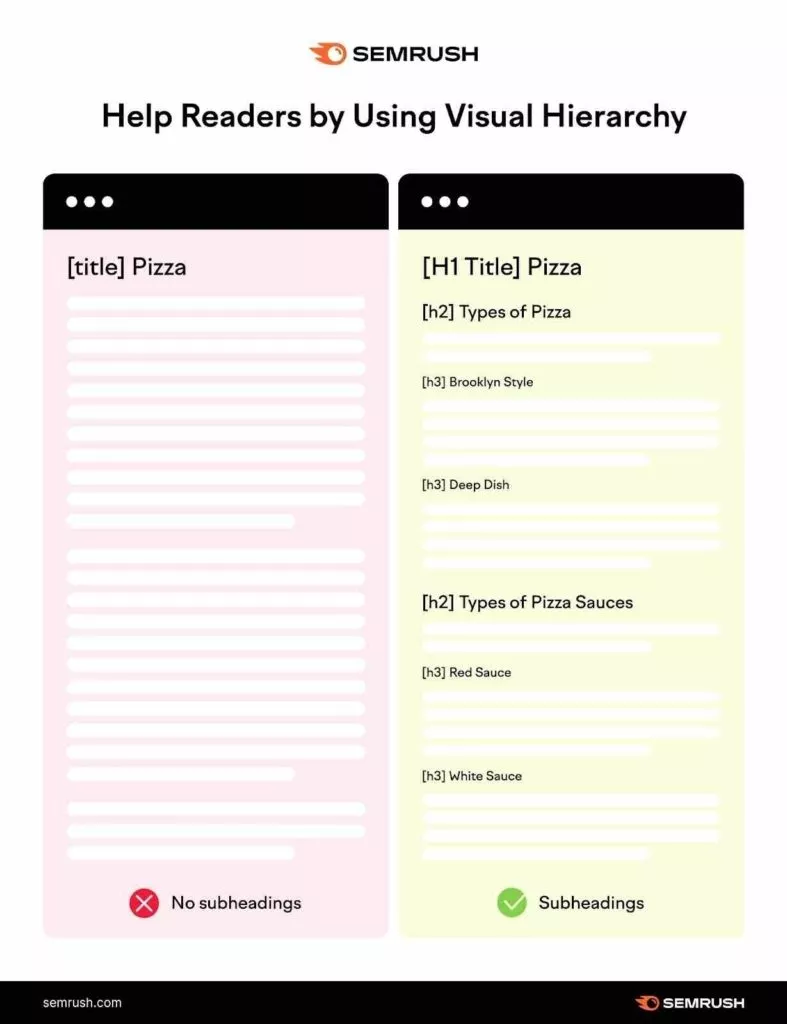
- Employ clear visual hierarchy with H2, H3, and/or H4 headings for each section.
- Optimize headers to provide a quick overview, assisting readers in finding specific information efficiently.
- Align headers with search intent, giving readers insights into the content of each section. Tip: Consider the inverted pyramid principle, placing the most important information at the beginning of paragraphs.
B. Clear and Informative Paragraphs:
- Break down content into short paragraphs for easy scanning.
- Commence paragraphs with the main idea or point, following the BLUF (Bottom Line Up Front) principle.
- Enable readers to quickly grasp essential information without navigating through dense text. Tip: Apply the BLUF principle to all content elements, including introductions and headings.
C. Short Sentences:
- Opt for shorter sentences to convey messages more efficiently.
- Enhance readability by presenting points concisely, streamlining the reader’s comprehension.
D. Simple Vocabulary:
- Avoid unnecessary jargon or technical terms unless the topic requires it.
- Opt for simplicity in language, ensuring that the average reader can readily understand the content. Example: Instead of using technical terms, opt for straightforward language that aligns with the target audience’s understanding.
- Sentence with Jargon: “Create content that moves users further down your sales funnel.”
- Revised Sentence: “Craft content that encourages users to make a purchase.”
E. Fine-Tuning Your Content:
- Leverage tools like Semrush’s SEO Writing Assistant to enhance readability, tone, and intent.
- Instantly assess readability scores and address potential complexities.
- Analyze text for plagiarism, keyword targeting, and alignment with the business’s tone of voice.
By implementing these strategies and utilizing SEO writing tools, you can refine your content to be more accessible, engaging, and aligned with both user preferences and search engine requirements.
8. Incorporate Visual Elements for Enhanced Engagement
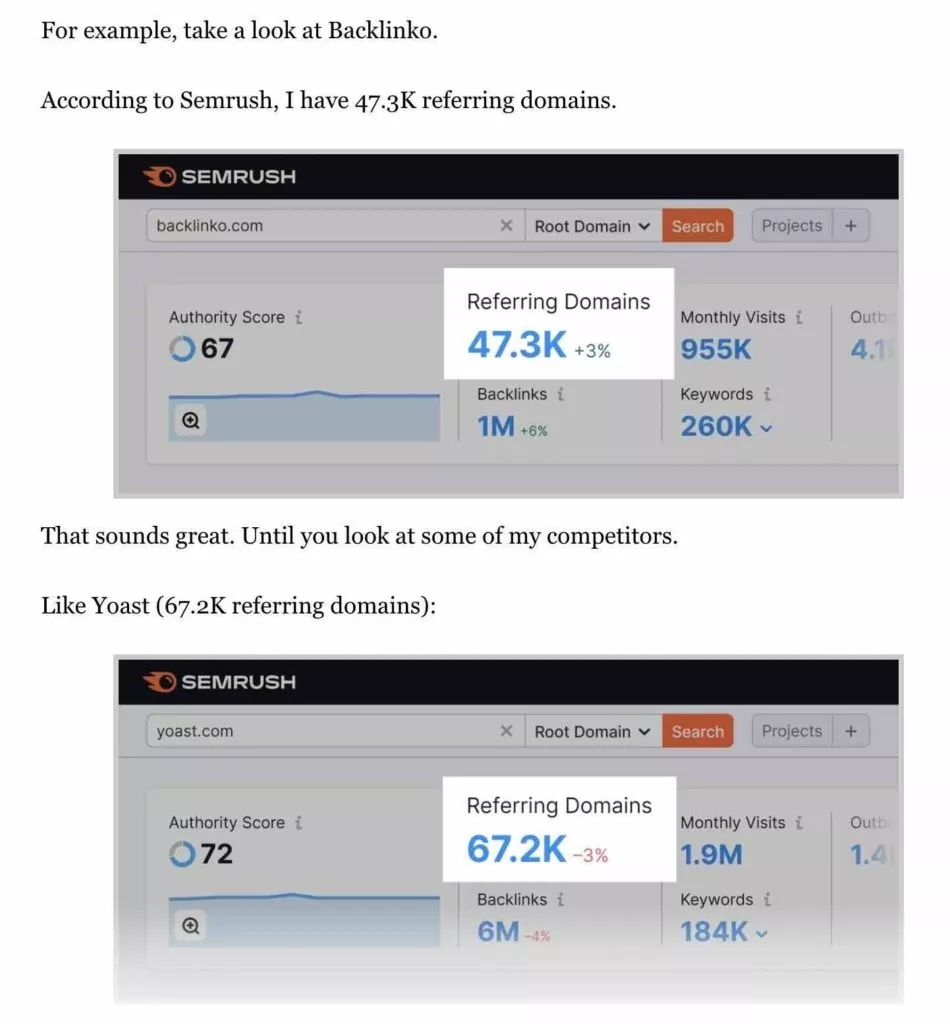
Integrating visuals into your webpage, such as videos, images, charts, and infographics, can significantly elevate user engagement. This practice, exemplified in the blog post from Backlinko, not only captures audience attention but also extends their time spent on the page, fostering social media sharing. To maximize the impact of visual content, adhere to image SEO best practices, ensuring optimal performance and accessibility.
Best Practices for Image SEO:
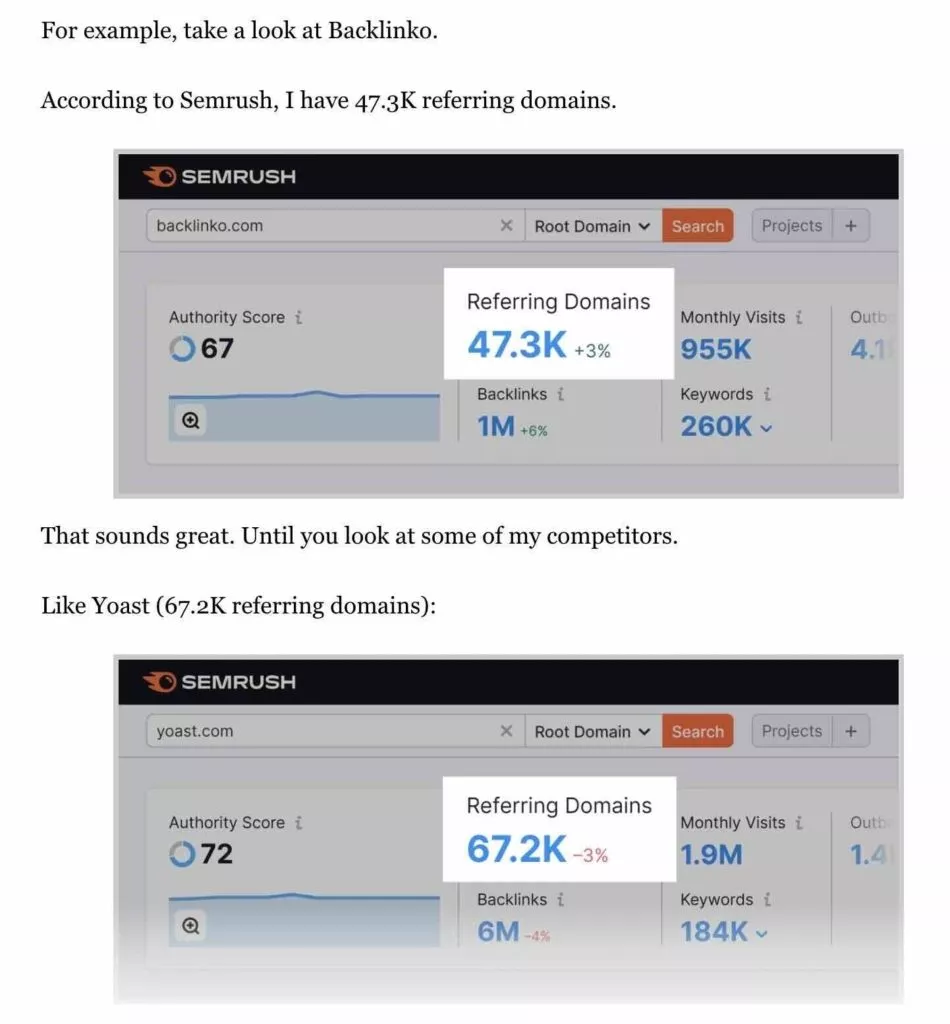
- Descriptive Filenames: Utilize filenames that succinctly describe the content of the image. Enhance search engine understanding and user accessibility through clear, relevant filenames.
- Image Compression: Compress images to minimize file size without compromising quality.
- Image Structured Data: Implement structured data markup for images to provide additional context to search engines. Enhance the visibility of images in search results, attracting more organic traffic.
- Optimized Alt Text: Craft informative and concise alt text for each image, describing its content accurately. Enable better comprehension for users with disabilities and contribute to overall SEO efforts. Accelerate webpage loading times, contributing to a seamless user experience.
9. Incorporate Compelling CTAs (Calls-to-Action)
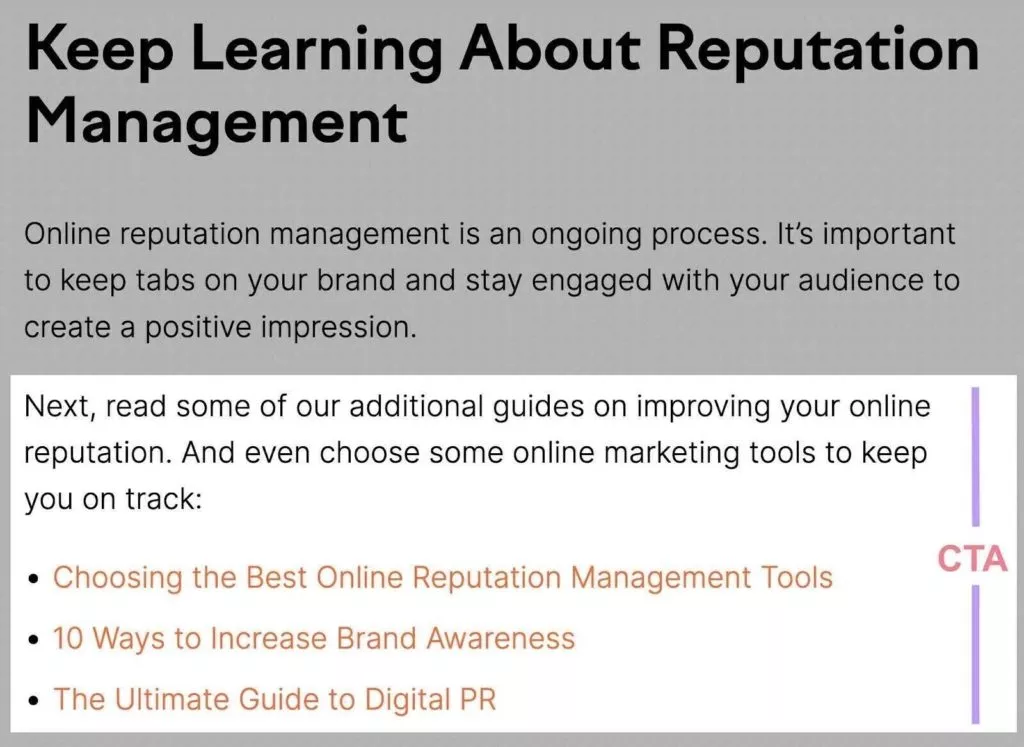
An integral aspect of SEO-focused copywriting is guiding users towards valuable conversions, such as making a purchase or completing a form. This is precisely where Calls-to-Action (CTAs) play a crucial role.
Consider the underlying “search intent” that brings users to your page. Whether they seek information or a specific product, strategically placed CTAs can seamlessly guide them to the next step in their journey. Utilize various elements like links, buttons, or images to prompt user actions effectively.
Advantages from Copywriting and SEO Perspectives:
- Enhanced Conversion Rates: Well-crafted CTAs can boost your copy’s conversion rate, optimizing the return on investment (ROI) of your content.
- Improved SEO Metrics: Strategically placed CTAs contribute to increased page views, reduced bounce rates, and positive engagement signals for search engines.
Pro Tip: To account for varied reading behaviors, strategically intersperse CTAs throughout your copy. However, maintain a purposeful approach to avoid overwhelming the page with excessive prompts. For instance, align a relevant CTA with specific product mentions, providing readers with an avenue to explore further.
10. Facilitate Navigation with a Table of Contents
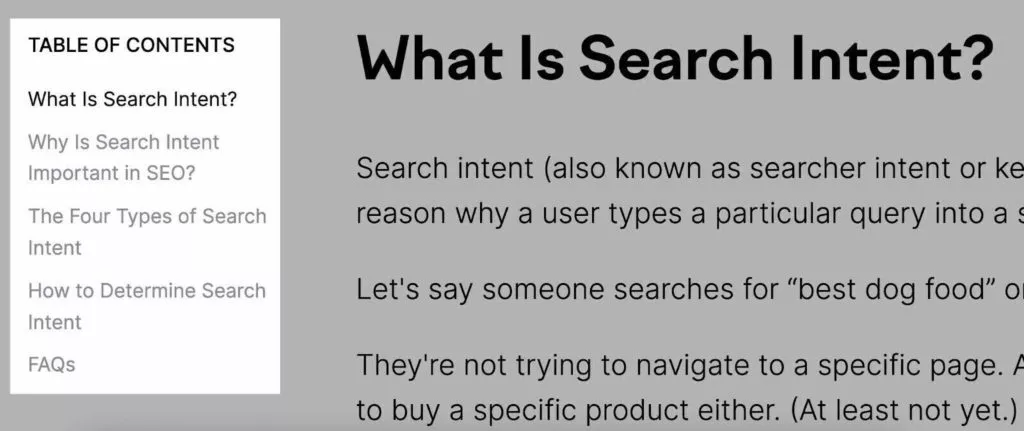
Including a table of contents serves as a roadmap for readers, offering a clear overview of what they can expect on the page. This practice aligns seamlessly with the goal of satisfying search intent.
Key Considerations:
- Descriptive Headings: Ensure that headings in the table of contents precisely depict the content of each section, maintaining thoroughness without overwhelming the reader.
- Engaging Content Trailers: Craft headings akin to a movie trailer, intriguing readers about the article’s essence and encouraging continued engagement.
- Confirmation of Relevance: A well-structured table of contents assists readers in confirming if the page aligns with their specific needs, enhancing overall user satisfaction.
By incorporating compelling CTAs and a user-friendly table of contents, your SEO-focused copywriting endeavors can effectively guide users, enhance conversions, and create a more engaging and navigable content experience.
Top Tools for SEO Copywriting:

1. Keyword Magic Tool: Precision in Keyword Targeting
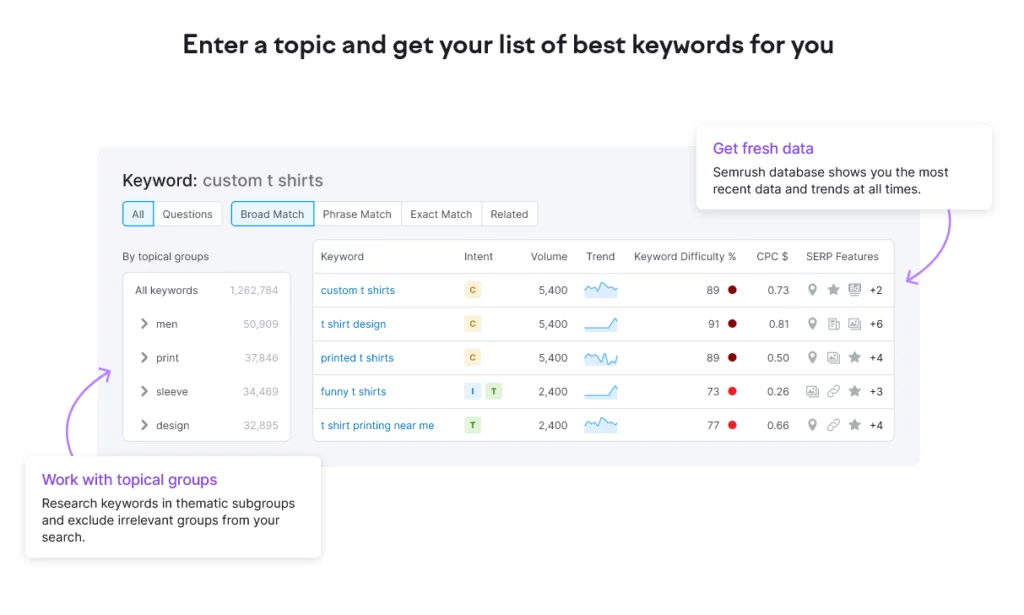
The Keyword Magic Tool is a paramount asset for SEO copywriters seeking precision in keyword targeting. Its objective is to assist users in identifying the most impactful keywords for their content. By providing a rich array of keyword data, including search volume, difficulty, and related terms, this tool empowers content creators to make informed decisions about the keywords they integrate into their content. With a streamlined interface, users can efficiently conduct keyword research, enhancing the effectiveness of their content strategies.
Pros:
- Rich keyword data for informed decision-making.
- Streamlined interface for efficient research.
Cons:
- Limited advanced filtering options.
2. Topic Research: Fostering Creativity in Content Ideation
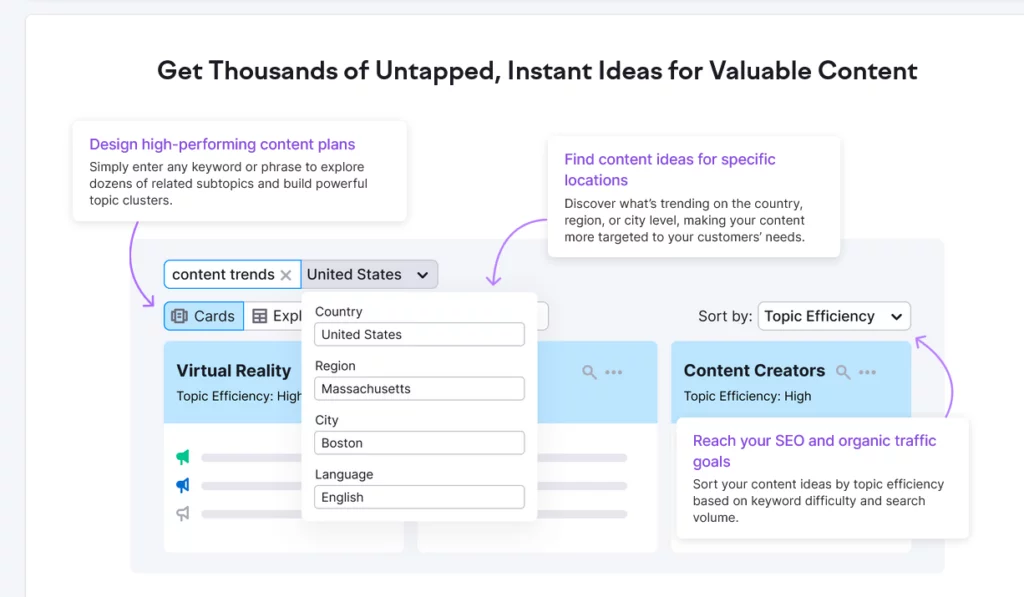
Topic Research serves as a creative hub for content ideation, offering a wealth of diverse and engaging content ideas. The tool’s objective is to inspire creativity by exploring the expansive landscape around a chosen topic. It goes beyond traditional keyword research, providing insights into trending subtopics, questions, and related searches. Integrated with SEO metrics, Topic Research ensures that content creation is not only imaginative but also data-driven, contributing to the overall effectiveness of digital marketing strategies.
Pros:
- Diverse content suggestions for enhanced creativity.
- Integration with SEO metrics for data-driven decisions.
Cons:
- Some users may find the interface overwhelming.
3. Organic Research: Benchmarking Competitor Content Performance
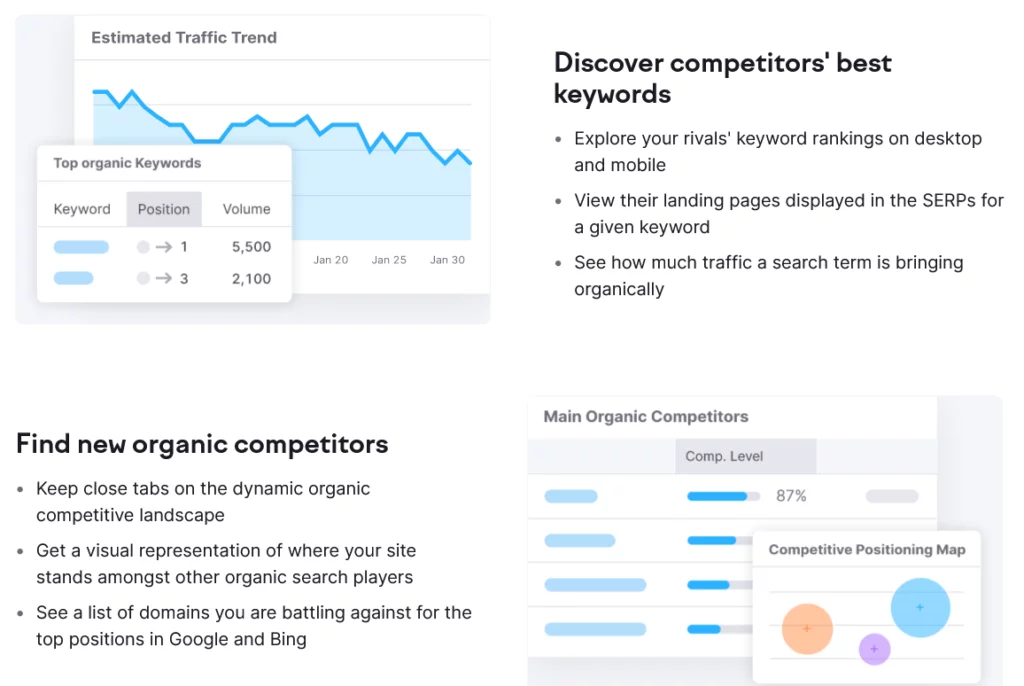
Organic Research is a strategic tool designed to benchmark and evaluate the performance of competitors’ content. Its objective is to provide users with a comprehensive view of how competitor content is faring organically. By offering insights into successful strategies, identifying content gaps, and facilitating a refined content approach, Organic Research enhances competitiveness in the digital landscape. While the tool requires a learning curve, its in-depth competitor analysis and historical data tracking make it a valuable asset for informed decision-making.
Pros:
- In-depth competitor analysis for strategic insights.
- Historical data tracking for performance trends.
Cons:
- Steeper learning curve for beginners.
4. SEO Writing Assistant: Real-Time Guidance for Content Creation
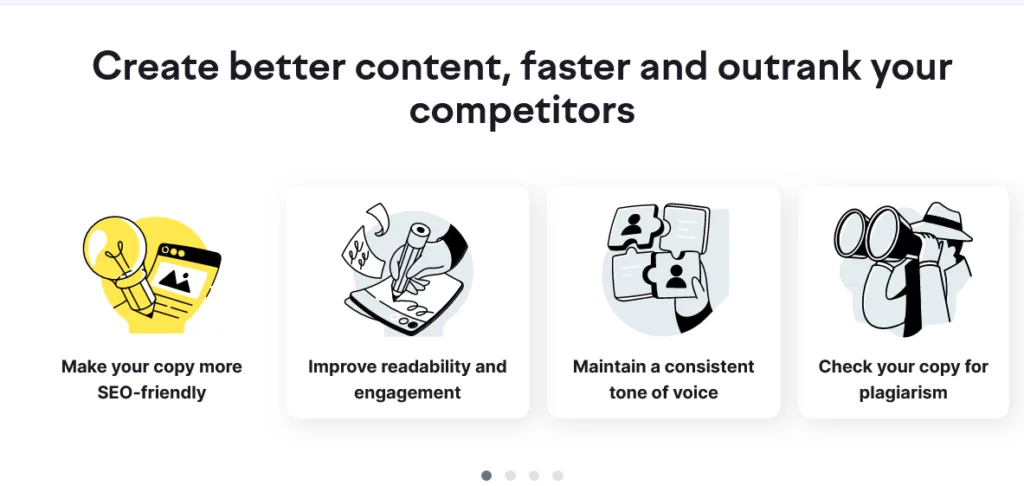
The SEO Writing Assistant is a dynamic tool that offers real-time guidance for content creation. Its objective is to analyze top-ranking pages for a specific keyword and deliver actionable recommendations to enhance content quality, readability, and SEO alignment. By providing immediate feedback and integrating seamlessly with popular content creation platforms, this tool ensures that the copy resonates effectively with both users and search engines. While language support may be limited for non-English content, the real-time insights make it a valuable companion in the content creation journey.
Pros:
- Real-time feedback for immediate improvements.
- Integration with popular content creation platforms.
Cons:
- Limited language support for non-English content.
5. On Page SEO Checker: Continuous Monitoring of Content Health
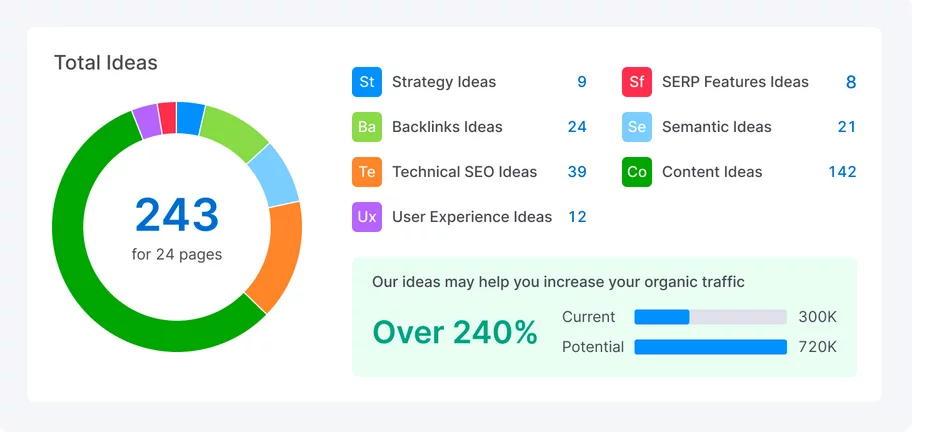
The On Page SEO Checker is a comprehensive tool designed for the continuous monitoring and auditing of published content. Its objective is to identify potential issues affecting SEO performance and suggest corrective actions. By conducting ongoing health checks, this tool ensures sustained content optimization. While the interface may be perceived as complex by some users, the actionable recommendations for issue resolution make it an invaluable asset for maintaining content health and effectiveness.
Pros:
- Ongoing health checks for sustained content optimization.
- Actionable recommendations for issue resolution.
Cons:
- Some users may find the interface complex.
6. SEO Content Template: Crafting Future-Ready Content Blueprints

The SEO Content Template is a forward-looking tool that provides users with strategic guidance for crafting future content blueprints. Its objective is to offer insights into recommended keywords, backlink opportunities, and structural suggestions based on the strategies of top-10 competitors. By providing a blueprint for future content creation, this tool ensures that upcoming content aligns with SEO best practices. Integrated with other Semrush tools, the SEO Content Template offers a seamless workflow for SEO copywriters. While customization options could be more extensive, the strategic guidance it provides makes it an essential tool for planning future content initiatives.
Pros:
- Strategic guidance for future content creation.
- Integration with other Semrush tools for seamless workflow.
Cons:
- Template customization options could be more extensive.
Conclusion:
Remember, the key lies in finding the perfect balance between creativity and optimization. As you navigate the intricacies of SEO copywriting, stay attuned to emerging trends, continuously refine your approach, and adapt to the ever-evolving digital landscape.
Armed with the insights shared in this guide, you are well-positioned to craft compelling, user-friendly content that not only ranks high on search engine result pages but also engages and converts your target audience.
FAQs on SEO Copywriting:
Is creativity important in SEO copywriting?
Absolutely. While optimization is crucial, creativity is equally important to engage and captivate your audience. Striking the right balance between creativity and optimization ensures content that appeals to both users and search engines.
What are common pitfalls in SEO copywriting to avoid?
Common pitfalls include keyword stuffing, neglecting user intent, and overlooking readability. Avoiding these mistakes ensures your content is well-received by both search engines and your audience.
Is there a preferred content length for SEO copywriting?
While there is no fixed rule, content that provides in-depth information and value tends to perform well. Focus on delivering comprehensive insights, and the length will naturally align with the depth of your topic.
How important is mobile optimization in SEO copywriting?
Mobile optimization is crucial. With a significant portion of internet users accessing content via mobile devices, ensuring that your content is mobile-friendly contributes to a positive user experience and can impact search engine rankings.



